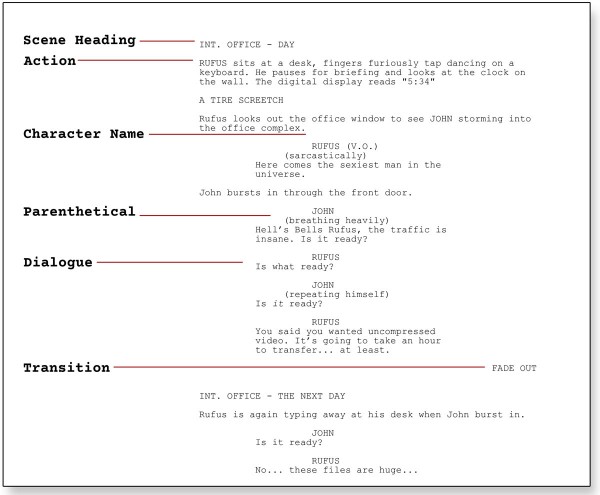Screenplay elements are what distinguish a screenplay from any other document. If the right screenplay elements are used in their correct positions, no one needs to tell someone who is a friend of the movie industry that the document he or she is holding is a screenplay.
Screenwriting is a form of visual storytelling, and these screenplay elements together would make your reader visually see the story you’re telling, so not knowing how and when to use these screenplay elements correctly would make your screenplay difficult to read and understand. In this post, you’ll be taught how to use these screenplay elements correctly so that you can visually tell your story and your screenplay won’t scream novice. There are six screenplay elements, and they are as follows:
1) Scene Heading or Slug Line.
2) Action or Action Description.
3) Character.
4) Parenthetical or Actor’s Direction.
5) Dialogue.
6) Transition.
Let’s see a photo gotten from Screencraft before the explanation begins.

SCREENPLAY ELEMENTS EXPLAINED
SCENE HEADING: A story is broken down into scenes in a screenplay, which simply means that we move from one scene to the next until the storytelling is complete. A scene heading is an instruction from the screenwriter given to everyone involved in the movie production. This instruction tells everyone “where and when” a particular scene is to be shot.
A scene heading or slug line majorly tells everyone involved in the movie production three things, and it’s the first thing that begins a scene. These three things are:
1) Where the scene is to be shot (INT. or EXT.)
2) The location and scene.
3) The time of day (day or night).
SCENE HEADING EXPLAINED
To give you a clear idea of what a scene heading or slug line looks like and how it’s used in a screenplay, we’ll be seeing some examples.
INT. CAR – DAY
The instruction from the screenwriter to everyone involved in the movie production based on the scene heading example above is that the scene should be shot inside a car during the day.
EXT. HOTEL – NIGHT
The instruction from the screenwriter to everyone involved in the movie production based on the scene heading example above is that the scene should be shot outside the hotel at night.
QUALITIES OF A GOOD SCENE HEADING
1) Capitalised: Scene headings or slug lines should only be written in capital letters. Writing a scene heading like this: “Ext. Hotel – Night” is totally wrong.
2) Clarity: Scene headings aren’t meant to confuse anyone. It should be easy to read and understand. Writing a scene heading like this: “INT. RICHARD’S HOUSE – DAY” would be confusing to the reader because he or she would be asking, “Where in Richard’s house should this scene be shot?”
As a screenwriter who wants to be seen as a professional, this is the correct way to write the scene heading: INT. RICHARD’S HOUSE – LIVING ROOM – DAY. Your reader will know straight away that you want this scene to be shot inside Richard’s living room and that it should be shot during the day.
ACTION DESCRIPTION: This is the second element of a screenplay, and as the name implies, the only thing that happens here is the description. When reading a screenplay, the action description is the next thing that follows a scene heading, and it basically describes three things. These three descriptions are:
a) Environmental Description.
b) Character Description.
c) Character’s Action Description.
ACTION DESCRIPTION EXPLAINED
1) Environmental Description: The screenwriter describes what he wants a particular character’s home, office, or wherever to look like. The environmental description isn’t always needed until the story says it is. Let’s see some examples.
a) KELVIN (30s) walks into a one-bedroom apartment with no furniture; it only has a bed that has clothes littered on it.
b) This house is a one-bedroom apartment with no furniture; it only has a bed that has clothes littered on it.
Do not describe an environment if it has nothing to do with the scene; don’t waste your reader’s time. When describing the environment, you should be careful of the things you mention because whatever you mention that can’t be gotten easily will cost money.
2) Character Description: The screenwriter tells the reader the name of his or her character(s), their age, and whatever else he or she feels is important for the reader to know about the character. The screenwriter doesn’t just write these things; there are rules when describing your characters.
RULES:
a) When you’re writing a character’s name in your action for the first time, you should write it in capital letters. For example: RICHARD, VICTORIA, and so on.
b) The next thing that follows the name is the character’s age. You can choose to be specific (32) or not (20s).
c) The next thing that follows the age is any special information the screenwriter has to give about the character he or she is introducing.
d) Whenever you want to mention the same character name again after the first time, you shouldn’t write it in capital letters.
Example:
a) RICHARD (32), a disabled man, picks up a stone and throws it at a car.
b) VICTORIA (20s), a lady who loves touching her ears, picks up a stone and throws it at a car.
c) GEORGE (40s) picks up a stone and throws it at a car. George takes off his slippers and runs away.
From the example above, you’ll see that I’ve been able to show you how the four rules listed above work.
3) Character’s Action Description: This is where the screenwriter describes the exact thing he or she wants the character(s) to do in the scene. Let’s see some examples.
a) STANLEY (32) sits on a couch reading a book as his phone rings.
b) DIANA (20s) opens the curtain to see Richard drive into the compound.
QUALITIES OF A GOOD ACTION DESCRIPTION
Remember, the goal of this post is to make your screenplay look professional; hence, you must write it the way professionals write theirs, and the following are the qualities of a professionally written action description.
a) Present Tense: Whenever you want to describe an action, write in the present tense.
b) Third Person: Action lines are written in the third-person singular. Pronouns such as “he,” “she,” “him,” “her,” or “it” should be used.
c) Clear: It should be concise, straight to the point, and easy to read and understand.
d) Dialogue: Write dialogue where dialogue belongs; it doesn’t belong in the action.
e) Left to Right: It should be written from the left margin of the page to the right margin of the page with no indentations.
Question:
a) Why should the action line be written in the present tense?
b) Why should action lines be written in third-person singular?
Answer:
a) As a screenwriter, whenever you write a screenplay, you’re telling a story that hasn’t been produced (watched), which means your writing is still alive, but when you write in the past tense, it means the story you’re telling has already happened, so why would you spend time writing what has already happened?
b) Action lines are written in third person because, as a screenwriter, you’re a third person in the lives of your characters, which simply means you’re an outsider who is looking into the lives of your characters.
CHARACTER: A character is an imaginary person in a story. When a character’s name first appears in the action description, it should appear in capital letters (CHARLES); afterwards, it can appear in normal letters (Charles).
The character’s name to begin a dialogue is written beneath the action description, not on the left margin but at the centre of the page. The character’s name must be written in capital letters.
PARENTHETICAL: This is an instruction from the screenwriter given to the actor who is taking up the role of the character, and this instruction appears in parenthesis or brackets beneath the character name. For example: (upset), (beat), (sarcastically), and so on.
DIALOGUE: This is the conversation that goes on between the characters. Dialogues appear either beneath the character name or beneath the parenthetical.
TRANSITION: Screenwriting is a form of visual storytelling; this means that, whilst writing, you as the screenwriter should be able to see how events would unfold on screen using your mind’s eye.
In post-production, the video editor executes the transition in movies, but as a screenwriter, you can instruct the video editor on how you want the transition in your screenplay to be. Do it only when it’s necessary.
These transitions are written on the right side of the page with a colon at the end. For example: CUT TO: , BACK TO: , DISSOLVE TO: ,
Even though the “popular” six screenplay elements have been mentioned above, there’s another element called “extension.” Let’s see an image from Writers store.

EXTENSION: We write extensions next to the character’s name on the right side and put them in brackets. There can be as many extensions as possible, but the most common extensions are:
a) (V.O.): This means voice-over.
b) (O.S.) or (O.C.): This means off-screen or off-camera.
